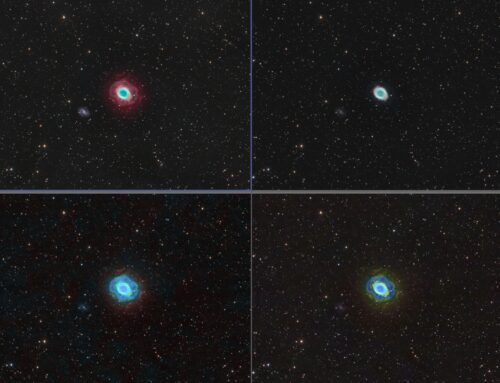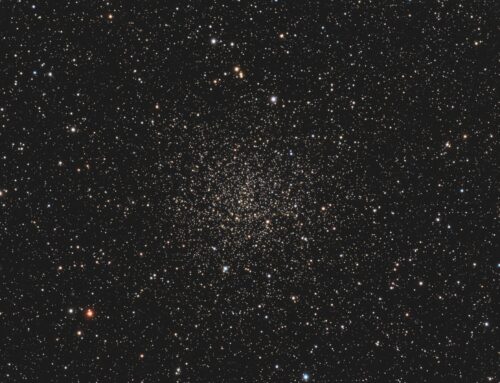NGC281, The Pacman Nebula (H-alpha)
Click image for full size version
October 2, 2015
NGC281 is known as the Pacman nebula. This nickname comes from its appearance, resembling an early video game character (you might see it more easily if you turn your head 90 degrees clockwise, or rotate the image counterclockwise). The designation NGC281 refers to the nebula; the star cluster in the centre is IC1590. These cluster stars were born out of this hydrogen gas, and now cause it to glow. The black dense globules are called Bok globules, from which the bright stars are born. The Pacman is about 9,500 light years away, and covers a little more sky than the full Moon. I imaged this object in colour previously (in 2011), but the current version shows significantly more detail including lots of curdling in the centre of the nebula and a ton of detail around the dark gash at left. A colour version that includes the current Ha data will be posted in the next few weeks, when I finish collecting and processing the required RGB data.
Tekkies:
SBIG STL-11000M camera, Baader Ha filter, 10″ f/6.8 ASA astrograph, Paramount MX. Guided with QHY5 guide camera and 80 mm f/6 Stellar-Vue refractor. Acquisition and guiding with TheSkyX. Focusing with FocusMax. Automation with CCDCommander. Calibration, cosmetic correction, registration, integration and all processing in PixInsight. Shot from my SkyShed in Guelph, Ontario. Moderate moonlight and good to very good transparency and seeing throughout acquisition.
18x30m Ha unbinned frames (total=9hr).
Ha
Creation and cleanup: Ha master was cropped and processed with DBE.
Linear Noise Reduction: MultiscaleLinearTransform was used to reduce noise in the background areas. Layer settings for threshold and strength: Layer 1: 3.0, 0.5 Layer 2: 2.0, 0.35 Layer 3: 1.0, 0.2 Layer 4: 0.5, 0.1
Deconvolution: A copy of the image was stretched to use as a deconvolution mask. A star mask was made from the unstretched Ha image to use as a local deringing support. Deconvolution was applied (75 iterations, regularized Richardson-Lucy, external PSF made using DynamicPSF tool with about 25 stars; local deringing at 70% and global dark deringing at 0.02).
Stretching: HistogramTransformation was applied to make a pleasing, bright image. TGV Noise was applied and the image was re-stretched to reset the black point.
HDR Processing: A mask was made to protect stars and background. HDRMultiscaleTransform was applied at a scale of 5 layers, followed by LocalHistogramEqualization at scales of 55 and 154 pixels (strength of 0.35 for each; all other settings default).
Final Processing
UnsharpMask was applied to the brightest structures in the nebula (scale 1.5, strength 50%, dark deringing at 0.01). Overall contrast was increased and brightness increased slightly with the Curves tool.
Image scale is about 1.1 arcsec per pixel for this camera / telescope combination.







Terrific image Ron